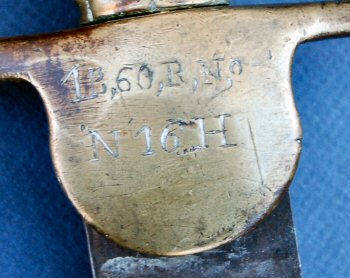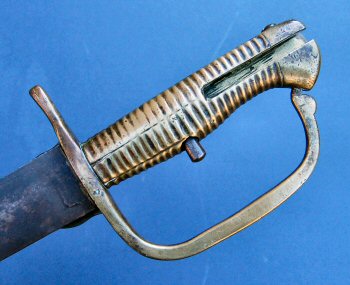
Great history associated to this piece, The langet is engraved (see photo) to the 1st. Battalion 60th. Regiment of Foot. I have never encountered such precise regimental attribution marked on a Baker bayonet. So a little research was in order, courtesy of fellow collector Graham Priest, the Royal Green Jackets Museum in the UK, and Wikipedia.
The origins of the 60th

The Regiment was raised in the American colonies in 1756 as the 62nd (Royal American) Regiment to defend the thirteen colonies against infiltration by the French and their native American allies.
Due to parliamentary delays it was 4th March 1756 before a special Act of Parliament created 4 battalions of 1,000 men to include foreigners for service in the Americas. Swiss and German forest fighting experts, American colonists and British volunteers from other British regiments were recruited. The battalions were raised on Governors Island, New York. The regiment was renumbered the 60th (Royal American) Regiment in 1757 when the 50th (Shirley's) and 51st (Pepperrell's) foot regiments were removed from the British Army roll after their surrender at Fort Oswego.
Among the distinguished foreign officers given commissions in the 60th (Royal Americans) was Henri Bouquet, a Swiss citizen, whose ideas on tactics, training and man-management (including the unofficial introduction of the rifle and 'battle-dress`) were only to become universal in the British Army after another 150 years. With his counterparts, Bouquet, the commanding officer of the 1st battalion, set about creating a unit that was uniquely suited to warfare in the forests and lakes that were the North American theatre of battle between Great Britain and France.
During the Napoleonic Wars the unit played a part in the Peninsular War. The first four regular battalions had been raised as regular line battalions, but a 5th battalion was raised and equipped entirely with the Baker rifle, and wore green jackets with red facings. The mixing of rifle troops and muskets proved popular enough that eventually the line battalion's light companies were replaced with rifle companies. The line battalions found themselves in different theatres, including the West Indies. The rifle battalion was soon supplemented with a second, and found themselves in the Peninsula with Wellington's army, serving along with the 95th Rifles, and the King's German Legion rifle units. A 7th battalion was eventually raised as a rifle battalion specifically for service in the American War of 1812.
The unit's name was not changed until after the Napoleonic Wars; first to The Duke of York's Own Rifle Corps and then in 1830 to the King's Royal Rifle Corps. The KRR was in turn amalgamated into the Royal Green Jackets in 1966.


Initial research into issue of rifles and bayonets
In 1758 Col. Bouquet’s 1st Battalion were issued with 16 rifles in Canada.
It was not until the 5th Battalion was raised in 1797 to add to the existing four battalions that the 60th served elsewhere, outside North America and the West Indies.
On its formation the 5th Battalion was armed with the Baker rifle. This was superseded by an improved pattern in 1803.
80 rifles and bayonets were bought for the 1/60th on 6th June 1805. The rest of the 740 men had muskets & bayonets in Jamaica in May/June 1808.
1/60th served in South Africa from 1811.
The 1/60th was reorganized in 1819 and the 2/60th became 1/60th. Stationed in Quebec, it was recorded in September of that year that they had 636 rifles & 659 bayonets.
Deeper research would be well worth the time spent. If you have any comments, or information to add, it would be most welcome.